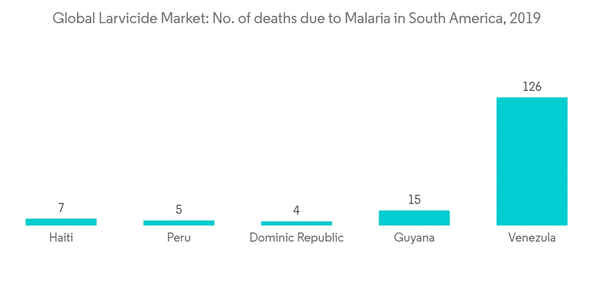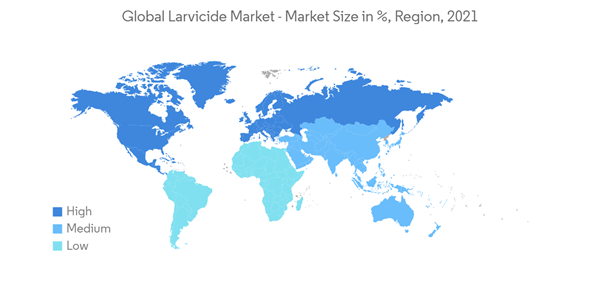The sudden outbreak of COVID-19 led to the implementation of stringent lockdown regulations across several nations, resulting in disruptions in the import and export activities of larvicides. Local government departments and mosquito control districts lead large-scale mosquito control activities during an outbreak. One activity is to apply larvicides. Licensed mosquito control professionals apply Environmental Protection Agency (EPA)-registered larvicides using backpack sprayers, trucks, or airplanes, depending on the size of the area being affected.
According to the WHO, 40% of the population living in underdeveloped countries is at risk of serious diseases, such as malaria, which is one of the life-threatening diseases caused by parasites transmitted by female anopheles mosquitoes. For instance, in 2017, there were an estimated 219 million malaria cases in 87 countries, and the total funding for malaria control was estimated at USD 3.1 billion. State contributions from tropical countries contributed to USD 900 million, accounting for 28% of total funding. An increasing number of disease outbreaks, vector-based epidemics, and growing pest attacks are some of the major factors driving the larvicides market globally. Among the regions, Asia-Pacific holds the major share in the larvicides market due to climate change, which poses a threat to public health caused by urban pests.
Larvicides Market Trends
Mosquito-borne Diseases Drive the Larvicides Market
Mosquito-borne diseases have become devastating in most countries, such as South America. Venezuela reported 126 deaths in 2019 due to malaria. Deadly diseases such as malaria, chikungunya, and dengue can be managed by larvicide. For example, the disease outbreaks such as the Zika virus have made the European region more susceptible to the spread of mosquito populations. Sub-Saharan Africa, the Middle-East, Latin America, Asia, and several parts of Europe are malaria-affected regions. Thus, the concerns about increasing dengue and malaria cases create an opportunity for the larvicides market in the target region. Additionally, government spending in the developing sector and the involvement of multinational companies drive the larvicides market.Factors such as the increasing prevalence of vector-borne diseases, epidemics, climatic changes, rising pest population, and ecological sustainability are driving the market's growth.
North America Dominates the Market
North America is estimated as the largest consumer due to the presence of many multinational companies in the region. The US and Canadian markets are huge due to effective surveillance and vector control programs. North America accounted for the largest share in 2017, followed by Europe. Asia-Pacific is projected to record the highest CAGR due to the spread of mosquito-borne diseases. High urbanization and rising public intolerance of pests are anticipated to fuel the larvicides market in the future.Liquid larvicide products are applied directly to water using sprayers. Tablet, pellet, granular, and briquet formulations of larvicides are also widely applied by mosquito controllers to breeding areas. In the United States, the Environment Protection Agency (US EPA) registered three major types of larval control agents, i.e., microbial larvicides, insect growth inhibitors, and chemical insecticides (mainly temephos). Bacillus thuringiensis israelensis (Bti) is a naturally occurring soil bacterium that can effectively kill mosquito larvae present in water. Aquabac, Teknar, Baltimore, and Vectobac are some of the commercially available Bti strains.
Larvicides Industry Overview
The larvicides market is highly fragmented. The major players use various strategies such as joint ventures, new product launches, partnerships, agreements, expansions, and mergers and acquisitions to increase their footprint in the market.Additional Benefits:
- The market estimate (ME) sheet in Excel format
- 3 months of analyst support
This product will be delivered within 2 business days.
Table of Contents
Companies Mentioned (Partial List)
A selection of companies mentioned in this report includes, but is not limited to:
- Adama
- BASF
- Sumitomo Chemical
- Certis
- Summit Chemical
- Nufarm
- Russell IPM
- Central Garden & Pet Co.
- Eli Lily and Company
- Syngenta










